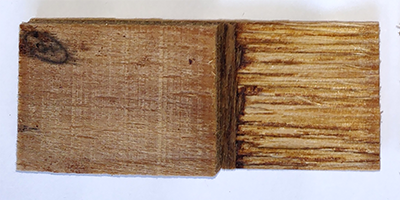FOR IMMEDIATE RELEASE | May 11, 2022
A nontoxic glue for plywood – from glucose, citric acid
“A Fully Bio-Based Adhesive from Glucose and Citric Acid for Plywood with High-Performance”
ACS Applied Materials & Interfaces
The go-to materials for building home furniture, décor and floors are composite wood products that come in large sheets. But the glues and resins holding together particleboard, fiberboard and plywood usually contain formaldehyde and could release this probable carcinogen into the air. To develop a nontoxic adhesive, researchers reporting in ACS Applied Materials & Interfaces have combined glucose and citric acid — sugar and an orange juice ingredient — into a strong, water-resistant wood glue for plywood.
To make plywood, manufacturers glue together thin layers of wood and then cure the material under pressure and heat, creating large, flexible panels. One of the most common adhesives is a urea-formaldehyde resin because it’s inexpensive and bonds strongly to wood. However, formaldehyde emissions from plywood with this type of resin have raised health and environmental concerns. Previous studies have shown that solutions of sucrose, a two-unit sugar made of glucose and fructose, and citric acid form a natural and water-resistant wood glue. But a zinc chloride catalyst is required to decrease the energy consumption for the plywood curing, which also reduces the adhesive’s strength. So, Hong Lei and colleagues wanted to see if pure glucose and citric acid could produce a strong adhesive with a less energy-intensive curing process.
The researchers heated solutions of glucose and varying amounts of citric acid into a sticky liquid that they applied onto poplar veneers. Then they stacked three veneers and pressed them into a single sheet at 392 F for six minutes. The team cut the sheets into smaller pieces for strength tests and found that under pressures greater than 101 psi, the plywood samples all broke along the wood fibers and not at the glued seams. These results satisfy the standard requirement for plywood in China. When the plywood samples were soaked in hot or boiling water, only the ones made with citric acid to glucose ratios above 0.6 had adhesive strengths that satisfied the standard requirement. The researchers attribute these results to the increase in ester links between citric acid and wood, which increased the wood-binding strength and water-resistance. Citric acid-glucose adhesives hold promise for the wood products industry, the researchers say.
The authors acknowledge funding from the National Natural Science Foundation of China, the Yunnan Provincial Natural Science Foundation, the 111 project and the French National Research Agency (ANR).
To automatically receive press releases from the American Chemical Society, contact newsroom@acs.org.
Note: ACS does not conduct research, but publishes and publicizes peer-reviewed scientific studies.
Media Contact
ACS Newsroom
newsroom@acs.org

View larger image

